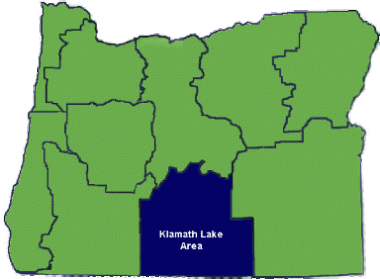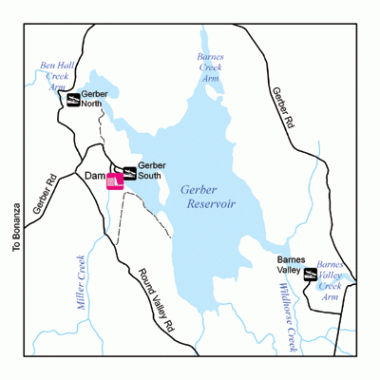
Warmwater Fishing in the Klamath Lake area
Oregon's Klamath and Lake counties offer outstanding warmwater fishing in the region's lakes and reservoirs, and even in the lower reaches of some of the rivers and streams. The area covers the Upper Klamath Basin and extends east to include the Chewaucan and Warner Lakes Basins.

For crappie, anglers will want to look to the east of Klamath Falls and try Willow Valley and Gerber reservoirs. Closer to Lakeview, Dog Lake offers good fishing for bass and crappie, while Crump and Hart lakes have crappie and catfish. For a unique fishing experience try Ana Reservoir, a 60-acre waterbody just north of Summer Lake where ODFW has stocked hybrid bass, a sterile cross between white bass and striped bass. The current state record hybrid was caught here. Other fish found in this area include: Largemouth Bass | Smallmouth Bass | Bullheads | Black Crappie | White Crappie | Bluegill | Pumpkinseed | Yellow Perch | Warmouth | Channel Catfish | Sacramento Perch
Featured waterbody - Gerber Reservoir
Nestled in the dry rimrock of south central Oregon, Gerber Reservoir is a pleasant surprise for anglers unaccustomed to warmwater fishing in the high desert. Gerber is located about midway between Klamath Falls and Lakeview, but well south of Hwy 140, the area's main east-west road. Access is easiest from Klamath Falls then east through Bonanza, a trip of less than one hour. From Lakeview, any of the shorter routes require travel on USFS roads so have directions or bring a map.
Gerber is a large reservoir of nearly 4,000 acres when full, but it's used to store water for irrigation so the water level can fluctuate throughout the year. Low lake levels during dry years will have a short-term impact on the fishery. However, the reservoir is very productive and fish recover quickly when water levels return to higher levels. Bank fishing is limited to the developed areas, an unimproved road that provides access on the west shore south of Gerber Dam, and several spur roads that access scattered locations along the Ben Hall and Barnes Valley arms.
Given its size and changing shoreline, it's easier to fish the reservoir by boat. In addition to a concrete ramp and fish cleaning station on the north end of the reservoir in the Ben Hall Arm, there is a concrete ramp near Gerber Dam, and a gravel ramp at the southeast end in the Barnes Valley arm. When the fishing is good, plan for an extended stay at one of the two campgrounds managed by the BLM.
Gerber is known for its crappie and yellow perch fishery, and has produced a state record white crappie of well over 4 pounds as well as perch up to 14-inches. Although not everyone can expect to land a record, large crappie over 12-inches are common. Crappie fishing will be most productive during the late spring and early summer in the arms of the tributaries (particularly the mouth of the Ben Hall arm), although success can be sporadic as the schools of fish move through an area. As the water warms during the summer, fish in the morning or evening and move to deeper water for mid-day. Target shoreline areas less than 15-feet deep that offer submerged cover such as rock piles, logs and willow unless the reservoir is particularly turbid, then try slightly shallower water.
Use light spinning gear with 4- to 6-pound test line rigged with around 2-4 feet of line between a bobber and bait, or bobber and jig. You can change the depth you're fishing by increasing the length between the bobber and jig. Start with a smaller 1/32 ounce jig then move to heavier weights if necessary. Local anglers find that some combination of white, yellow, or red and white jigs work best for crappie and perch at Gerber. If you’re fishing from a boat, anchor or drift about 50 feet off shore, cast into shore and retrieve slowly.
Fishing for yellow perch will be best during the spring and fall when they are in shallow areas, and more difficult in the summer when they move to deeper and cooler water. They can also be caught during the winter months when ice fishing is popular at Gerber.
A bobber and jig combination similar to that used for crappie will work for perch, but you’ll likely have greater success using a hook baited with a worm or other panfish bait. If the fish are in deeper water, use a lead weight instead of a bobber to get the bait close to the bottom.
Spring, summer, and fall are also good times to fish for largemouth bass. As the water warms in the spring, largemouth move into the shallow and shoreline areas to spawn. The fish will be aggressive during this period and a variety of lures, jigs and plastic baits can be effective. Use spinners, spinnerbaits or buzzbaits to fish on or near the surface, particularly in areas where the weeds are thicker. To fish deeper water, lures and jigs that imitate prey such as small fish and crayfish, and soft plastic worms work well. After the spawn and throughout the summer, the bass can be more difficult to catch. Continue to fish the weedy areas along the shoreline during the morning and evening, but fish deeper water during mid-day. Bass fishing will improve again as the water cools in the fall.
Gerber also provides fishing for brown bullhead catfish. For catfish, worms or baits with a strong odor work well. Fish with light or medium spinning tackle rigged with 4- to 8-pound test line and use a sliding sinker rig so the fish can take the bait before feeling the pull of the weight. Catfish can be caught throughout the day near shore in the deeper holes and troughs, but fishing will be best during the evening and night when fish move into the shallows to feed.
Other great places to go warmwater fishing in the Klamath Lake area:
Find your place to fish:
Header image by Kathy Munsel



